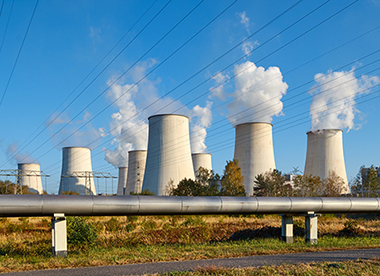
In October 2015, EPA adopted CO2 standards for existing power plants under Section 111(d) – the Clean Power Plan.[2] Section 111(d) directs EPA to decide the amount of emission reduction that must be achieved by determining the “best system of emission reduction [(BSER)] . . . that has adequately demonstrated for [the existing covered] facilities.”[3] In the Clean Power Plan, EPA determined BSER included three types of measures:
- Improving the heat rate at affected coal-fired plants to burn coal more efficiently;
- Generation shifting from higher-emitting coal-fired plants to lower-emitting natural gas plants; and
- Generation shifting from coal-fired and natural gas plants to renewable energy units.[4]
EPA touted that these measures could also be accomplished through the purchase of allowances as part of a cap-and-trade system.[5]
In determining whether EPA has the authority under Section 111(d) to essentially require only generation shifting, the Court invoked the “major questions doctrine,” which requires a federal agency point to “clear congressional authorization” for it to adopt rules with broad importance and societal impact.[6] The Court found that EPA could not point to such “clear congressional authorization” for two primary reasons:
- Section 111 has historically applied to individual sources and not system-wide.
The Court found that Section 111(d) was intended to be a technology-based approach that focuses on improving emissions performance at individual sources and not on improvement of overall power systems.[7] Based on this precedent (and in the narrow context of the major questions doctrine), the Court found it highly unlikely that Congress intended EPA to determine the amount of coal-based generation nationwide. The Court feared that if EPA could fundamentally revise the scheme of Section 111(d), “it could go further, perhaps forcing coal plants to ‘shift’ away virtually of all their generation–i.e., to cease making power altogether.”[8] Notably, the Court declined to opine on whether the phrase “system of emission reduction” refers exclusively to measures implemented on individual sources or whether EPA could regulate beyond the fence line of a source.[9]
- A cap-and-trade system is not BSER
The Court rejected EPA’s argument that a cap-and-trade system is the kind of “system” within the meaning of BSER in Section 111. The Court distinguished the cap-and-trade system (and other sector-wide mechanisms) in the Clean Power Plan with the trading systems found in the Clean Air Act’s Acid Rain and National Ambient Air Quality Standards (NAAQS) programs.[10] The Court found that, unlike Section 111(d), the Acid Rain and NAAQS programs specifically contemplated trading systems as a means of complying with an already established limit set by Congress or the appropriate NAAQS pollutant concentration.[11] In the Clean Power Plan, EPA devised the emissions cap itself. The Court also noted that Congress has consistently rejected proposals to amend the Clean Air Act to create such a trading program and declined to enact similar measures, such as a carbon tax.[12] The Court concluded that, since Congress did not specifically authorize a trading system in Section 111, a trading system is not something Congress intended to be a BSER.[13]
The West Virginia v. EPA decision may have implications on the validity of cap-and-trade systems that are not explicitly authorized by Congress in statute. Other examples of EPA rules with trading programs not explicitly authorized might in Clean Air Act might include the 2005 Mercury Rule, the Regional Haze Rule and the Cross-State Air Pollution Rules.
If you have questions, please contact members of the firm’s Environmental group: Carlos Romo, Jennifer Biever, Clay Taylor and Dale Ratliff.
About Williams Weese Pepple & Ferguson
The business and commercial law practice of Williams Weese Pepple & Ferguson has been a respected institution for more than four decades. Over the years, we’ve earned a reputation for placing the highest value on close personal relationships with our clients and working tirelessly to achieve successful and efficient outcomes. We practice in Colorado, the Rocky Mountain region, and beyond. Our attorneys offer expertise in commercial and regulatory litigation, employment, energy, natural resources, the environment, oil and gas, federal lands, ski resorts, real estate, private client, trusts and estates, tax, corporate counseling and transactions, mergers and acquisitions. The firm is locally and nationally known for efficiently and expertly handling big-firm sophisticated work with small-firm client service and attention.
https://www.linkedin.com/company/williams-weese-pepple-ferguson
[1] W. Virginia v. Env’t Prot. Agency, No. 20-1530, 2022 WL 2347278, at *18 (U.S. June 30, 2022).
[2] 80 Fed. Reg. 64,662 (Oct. 23, 2015).
[3] 40 C.F.R. § 60.22(b)(5).
[4] 80 Fed. Reg. at 64,707.
[5] Id. at 64,738.
[6] W. Virginia v. Env’t Prot. Agency at *13.
[7] Id. at *14 – *15. The Court noted that the emission performance rates developed by EPA were “so strict that no existing coal plant would have been able to achieve them without engaging in generation shifting.” Id. at *8.
[8] Id. at *15.
[9] Id. at *18.
[10] Id. at *17.
[11] Id. at *18.
[12] Id. at *16.
[13] Id. at *17.
